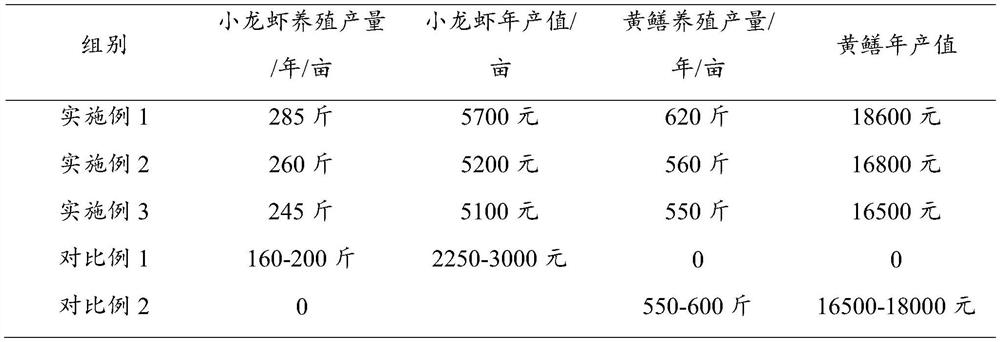A method for comprehensive cultivation of eel, shrimp and rice
A technology of paddy field and yellow eel, applied in the field of comprehensive cultivation of eel, shrimp and rice, can solve the problems of low breeding efficiency and not maximizing breeding efficiency, and achieve the effect of improving the cultivation size
- Summary
- Abstract
- Description
- Claims
- Application Information
AI Technical Summary
Problems solved by technology
Method used
Image
Examples
Embodiment 1
[0023] A kind of comprehensive planting and raising method of eel, shrimp and rice provided by the present embodiment, taking the Jianghan Plain area as an example, carries out according to the following steps:
[0024] 1. Production and installation of eel hatching equipment
[0025] The transformation of eel, shrimp and rice integrated rice fields is the same as that of shrimp and rice co-cultured rice fields. It is carried out in winter, with 4m wide and 1.5m deep breeding ditches excavated, rice fields leveled, and supporting water inlet and drainage facilities constructed. Before the seedlings of crayfish are released at the end of March, each mu (667m 2 ) Paddy fields are thoroughly disinfected by splashing 75-100kg of quicklime to remove wild fish such as eels and loaches stored in the rice fields.
[0026] 2. Crayfish farming
[0027] At the end of March and the beginning of April, when the water temperature reached above 18 degrees, seedlings of crayfish were put in...
Embodiment 2
[0037] A kind of comprehensive planting and raising method of eel, shrimp and rice provided by the present embodiment, taking the Jianghan Plain area as an example, carries out according to the following steps:
[0038] 1. The production and installation of the eel hatching equipment are the same as in Example 1.
[0039] 2. Crayfish farming
[0040] At the end of March and the beginning of April, when the water temperature reached above 18 degrees, the seedlings of crayfish began to be put in, and about 5,000 crayfish seedlings weighing 4g were put in per mu of paddy field. Breeding and management are carried out in accordance with the shrimp-rice co-cultivation regulations. The fishing starts in mid-May, and the big ones are kept small. When the water temperature reaches above 28°C in late June, the crayfish begin to live in caves and make holes, and almost no shrimps get into the shrimp cages. stop fishing.
[0041] 3. Transplanting of rice
[0042] After stopping fishin...
Embodiment 3
[0050] A kind of comprehensive planting and raising method of eel, shrimp and rice provided by the present embodiment, taking the Jianghan Plain area as an example, carries out according to the following steps:
[0051] 1. The production and installation of the eel hatching equipment are the same as in Example 1.
[0052] 2. Crayfish farming
[0053] At the end of March and the beginning of April, when the water temperature reached above 18 degrees, seedlings of crayfish were put in, and about 4,000 seedlings of crayfish weighing 6g were put in per mu of paddy field. Breeding and management are carried out in accordance with the shrimp-rice co-cultivation regulations. The fishing starts in mid-May, and the big ones are kept small. When the water temperature reaches above 28°C in late June, the crayfish begin to live in caves and make holes, and almost no shrimps get into the shrimp cages. stop fishing.
[0054] 3. Transplanting of rice
[0055] After stopping fishing, relea...
PUM
 Login to View More
Login to View More Abstract
Description
Claims
Application Information
 Login to View More
Login to View More - R&D
- Intellectual Property
- Life Sciences
- Materials
- Tech Scout
- Unparalleled Data Quality
- Higher Quality Content
- 60% Fewer Hallucinations
Browse by: Latest US Patents, China's latest patents, Technical Efficacy Thesaurus, Application Domain, Technology Topic, Popular Technical Reports.
© 2025 PatSnap. All rights reserved.Legal|Privacy policy|Modern Slavery Act Transparency Statement|Sitemap|About US| Contact US: help@patsnap.com

